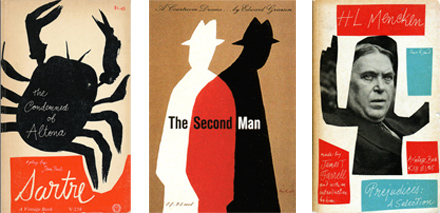 Paul Rand’s essay on “The Politics of Design”.
Paul Rand’s essay on “The Politics of Design”.
In this excerpt, Rand explains why presenting many solutions to a problem leads to waste and confusion.
Graphic designer Paul Rand created classic logos and striking book covers during his career. Steve Jobs talked about working with Paul Rand in 1993.
**********************
One of the more common problems which tends to create doubt and confusion is caused by the inexperienced and anxious executive who innocently expects, or even demands, to see not one but many solutions to a problem. These may include a number of visual and/or verbal concepts, an assortment of layouts, a variety of pictures and color schemes, as well as a choice of type styles. He needs the reassurance of numbers and the opportunity to exercise his personal preferences. He is also most likely to be the one to insist on endless revisions with unrealistic deadlines, adding to an already wasteful and time-consuming ritual. Theoretically, a great number of ideas assures a great number of choices, but such choices are essentially quantitative. This practice is as bewildering as it is wasteful. It discourages spontaneity, encourages indifference, and more often than not produces results which are neither distinguished, interesting, nor effective. In short, good ideas rarely come in bunches.
 The designer who voluntarily presents his client with a batch of layouts does so not out prolificacy, but out of uncertainty or fear. He thus encourages the client to assume the role of referee. In the event of genuine need, however, the skillful designer is able to produce a reasonable number of good ideas. But quantity by demand is quite different than quantity by choice. Design is a time-consuming occupation. Whatever his working habits, the designer fills many a wastebasket in order to produce one good idea. Advertising agencies can be especially guilty in this numbers game. Bent on impressing the client with their ardor, they present a welter of layouts, many of which are superficial interpretations of potentially good ideas, or slick renderings of trite ones…
The designer who voluntarily presents his client with a batch of layouts does so not out prolificacy, but out of uncertainty or fear. He thus encourages the client to assume the role of referee. In the event of genuine need, however, the skillful designer is able to produce a reasonable number of good ideas. But quantity by demand is quite different than quantity by choice. Design is a time-consuming occupation. Whatever his working habits, the designer fills many a wastebasket in order to produce one good idea. Advertising agencies can be especially guilty in this numbers game. Bent on impressing the client with their ardor, they present a welter of layouts, many of which are superficial interpretations of potentially good ideas, or slick renderings of trite ones…
Expertise in business administration, journalism, accounting, or selling, though necessary in its place, is not expertise in problems dealing with visual appearance. The salesman who can sell you the most sophisticated computer typesetting equipment is rarely one who appreciates fine typography or elegant proportions. Actually, the plethora of bad design that we see all around us can probably be attributed as much to good salesmanship as to bad taste.
Excerpt from A Designer’s Art, Paul Rand, Yale University Press (1985)
**********************
The more design variations you show seems to be in direct correlation with the vagueness of the project brief/goals/objectives.
It’s usually a sign that things moved into the visual exploration stage too early in the process. Proper design requires properly defined objectives to design against. Once those are properly defined, the range of potential successful design solutions is narrowed significantly.



